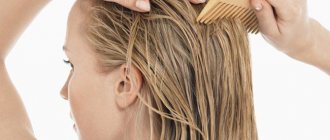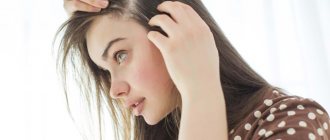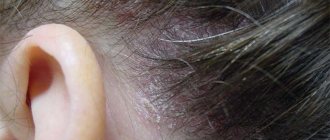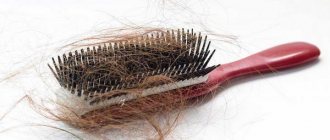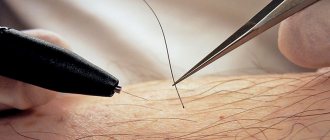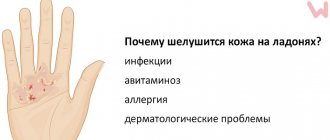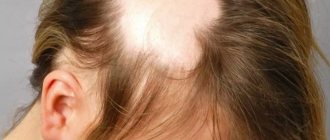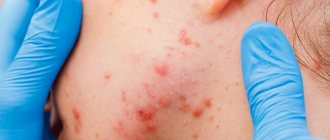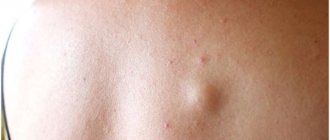From this article you will learn:
- How does alopecia areata manifest in women?
- What types of alopecia are there?
- What are the stages of alopecia areata in women?
- What are the causes of alopecia areata in women?
- How to diagnose alopecia areata in women
- How is alopecia areata treated in women?
- What are the ways to accelerate hair growth after alopecia areata in women?
- Is it possible to completely cure alopecia areata in women?
- What preventative measures exist to prevent alopecia areata in women?
Alopecia areata in women (baldness) is a problem that can occur at any age, but primary symptoms are often observed in women aged 15–35 years. Most people eliminate this disease in one or several years, but it happens that the disease becomes chronic, then it worsens constantly.
Focal baldness does not affect the health of the body as a whole, but is a cosmetic defect in aesthetic terms. If the disease becomes severe, the consequences can be dangerous.
How does alopecia areata manifest in women?
Alopecia areata already by its name explains that damage to this disease occurs locally, and not throughout the scalp. Cluster-type baldness is characterized by the formation of one or more round or oval-shaped lesions. The skin at the site of the bald spot does not differ in color, does not itch, and there are no rashes on it.
In most cases, alopecia areata in women does not cause discomfort. The initial period of the disease is characterized by very rapid and profuse hair loss in a specific area. If the disease is concentrated in a small area of the head, it usually goes away on its own and does not require therapy. If several bald patches form at once or a relapse occurs, you should consult a doctor.
In men, women and even children, the disease manifests itself in the same way: there is continuous hair loss in a certain area. Several bald spots can form, and if appropriate treatment is not carried out, they can grow and join together.
Main symptoms of the disease:
- smooth surface of the skin, on which in some cases a barely noticeable fluff is visible;
- there is an inflammatory process in the area of hair loss;
- the bald area becomes oval or round in shape;
- very rarely there is itching at the site of hair loss;
- the affected skin turns red and wounds form on it;
- the hairs become very brittle and this causes areas to form as if they had been shaved.
Why does hair fall out when washing your hair?
The question of why hair falls out often comes to people when they observe hair loss when washing their hair. What is this connected with? It would seem that each hair has its own life cycle, according to which it must fall out at a strictly defined time, and suddenly wet hair appears in your hands or on the comb. How can it be? Why does it always happen in such circumstances?
In fact, there is nothing surprising in this phenomenon. It's really time for this hair to fall off. They had served their purpose and were only waiting for suitable circumstances or that possible time until which they could hold out a little longer. By dousing your head, you cause your hair to get wet, which means it becomes heavier. The extra weight causes old hairs to separate from the follicles. Don't worry - nothing like this can happen to healthy, young hair. This phenomenon is likely only for those hairs that would fall off in the near future. You are only speeding up the process a little.
And yet, excessive zeal when washing, drying, and combing your hair is undesirable, since by applying force, you risk damaging the hair that could still last for a long time. Be careful.
Alopecia areata and other types of baldness
The photo of alopecia areata in women presented below demonstrates the stages of development of this disease.
Alopecia areata in women manifests itself in one of the following forms:
- Local. Areas of the oval contour where excessive hair loss occurs are identified.
- Ribbon-shaped. It is one of the most unfavorable forms of the disease. A painful lesion, on which almost no hair grows, runs from the back of the head to the temples and resembles a ribbon shape.
- Subtotal. At the initial stage, it is expressed by small lesions, which women carefully hide. But after some time, the disease progresses, the lesions become larger and connect.
- Total. It is a uniform loss of hair over the entire surface of a woman’s head; loss of eyelashes and eyebrows can also be observed.
- Universal. Hair loss occurs throughout the body. This form of the disease can develop over decades, affecting new and new areas. It happens that hair grows in previously bald areas, but at the same time new pathological foci form. From time to time, short-term remissions occur, which almost always result in relapses. A woman experiences unpleasant sensations in the first months of the disease, then during an exacerbation they are practically absent.
- Alopecia areata. The pathological process of hair loss occurs very quickly, and the nail plates are involved in it. This type of disease is a complicated form that is difficult to cure.
Stages of alopecia areata in women
There are the following phases of the disease:
Phase No. 1. Progressive. Characterized by swelling of the skin in areas where hair is almost completely absent. Hyperemia almost always occurs, and inflammation may occur. There are complaints from patients about severe itching, tingling and burning sensations. There are very short hairs near the place where complete baldness occurred.
There is accelerated hair loss in areas adjacent to bald patches. In most cases, women notice this sign of baldness while combing, but it happens that it is detected when touching the hair. Hair follicles have a dystrophic shape, indicating problems.
Phase No. 2. Subacute. This stage is characterized by the rare appearance of foci of inflammation, which are quickly replaced by others. There may be no inflammatory reactions at all. In areas of baldness, pale skin and absence of areas with short hair lengths are observed.
Phase No. 3. Regression. On bald patches, hair growth occurs, which has a fine structure. In most cases they are light, then undergo pigmentation. Their appearance improves as they grow.
If alopecia areata in women is mild, there is no deformation of the nails. Signs of mild dystrophy of the nail plate are observed in less than 20% of affected women.
The nested and universal forms affect the nails of almost all patients. They become more fragile, ribbing appears in the structure, and a wavy pattern appears along the edges.
We can talk about the chronic course of the disease if typical symptoms appear for six months or more.
Recommended articles on the topic:
- How to choose a hairstyle based on your face shape and online
- Dry hair care
- Haircut for women over 50: tips for choosing and suitable options
Why hair falls out: interesting facts
First of all, in order to answer the question of why hair falls out on the heads of men and women, you need to understand how this part of the human body is structured, what it consists of, and what features it has.
Hair is a living part of the body, like, for example, eyes or lips. It is distinguished by the absence of the circulatory and nervous systems and is an appendage of the skin. Some information about hair:
- The hair is divided into two parts: the root is located inside the skin, the shaft is located outside;
- The hair follicle is a component of the root - the very part from which hair grows;
- Each bulb is approached by a structure that feeds it: a papilla with vessels;
- Follicle (hair follicle) is a sheath for the hair root, connected to the sebaceous and sometimes sweat glands.
The hair shaft consists of three layers:
- Medula
- the medulla running in the very center of the hair. Due to the air bubbles contained within it, it provides thermal conductivity to the hair.
- Cortex
- a huge number of keratin fibers, numbering in the thousands. They twist together, intertwining like a rope. In fact, this layer makes up 4/5 of the total hair structure. In addition, this is where the pigments that determine their color are contained.
- Cuticle
- the outer layer necessary to provide protection to the hair. In addition to the barrier function, it is also responsible for the appearance, since it is located on the outside, and, in addition, it imparts shine and hardness. The cuticle consists of keratin plates. The stronger these elements, the stronger the hair.
Chemically, creatine and protein predominate in hair, accounting for almost 4/5 of the total structure. In addition to them, there is a significant percentage of water (up to 15%), about 1/10 fat and only 1%, which is responsible for color - pigment.
The life cycle of hair is usually divided into three main phases:
- Anagen phase - when hair is formed from cells, during this period the length and thickness are determined;
- The catagen phase is a calm and short-lived state, during which beneficial substances cease to flow to the hair;
- The telogen phase is the final stage in the life of a hair, at the end of which it falls off.
Then the birth of a new hair begins. The average number of hairs that can grow from one follicle is 25.
Interesting facts about hair:
- Each hair is constantly growing, but it can slow down and speed up, and this depends not only on the season, but even on the time of day;
- All people's hair grows at different rates depending on the individual characteristics of the body, but on average it is about 15 millimeters in 30 days;
- The average person has between one hundred and one hundred and fifty thousand hairs on their head;
- Blondes have more hair than others, redheads have the least;
- Over the course of a day, a healthy person can lose approximately 75 hairs.
Causes of alopecia areata in women
The origin of alopecia areata in women and the reasons for its appearance are almost impossible to establish accurately. However, there is a list of factors that can affect the onset of this disease:
- Heredity. Everyone knows that many diseases are transmitted this way. If there has been a tendency for excessive hair loss in the male line, there is a high probability of baldness in their children.
- Autoimmune processes. This is the case when the cells of the immune system themselves block hair growth or destroy it. However, the therapy that is used does not produce positive results, so this reason has not yet been proven.
- Infectious diseases. Serious illnesses that a woman has suffered can cause hair loss on all parts of the body. Various fungal infections of the skin can also cause this deviation.
- Stress. There are patients whose bald spots began to appear as a result of suffering a moral shock.
- Injuries and cuts. There are cases when a person hits his head and damages his hair and severely injures the follicles, which can subsequently shed hair.
Read material on the topic: Why hair falls out: 10+ possible reasons
Why does hair fall out in summer?
The question of why hair falls out becomes especially relevant on summer days. This is due to the fact that in addition to the “usual” negative factors for this phenomenon, such as diseases or lack of vitamins, new circumstances arise. This includes neglect of the rules of care necessary in the summer, and many other features that should be taken into account. The main ones will be listed below.
Reason #1. Your headdress
Various things can happen to a headdress. For example, if it is too dense, then due to excessive overheating the hair will begin to fray. This process will eventually trigger hair loss.
But the absence of a headdress is not a solution in this case. An open head will become a target for ultraviolet radiation emitted by the sun, which will also negatively affect the condition of the hair and lead to hair loss.
What will help? As a rule, the solution to the problem is quite simple - a normal hat that provides sufficient ventilation and prevents the penetration of sunlight. In cases where a hat is inappropriate, you can use special products that will block the effects of ultraviolet radiation.
Reason #2. Styling products
It is known that various mechanical and thermal effects on hair, for example, the use of straightening irons or curling irons, lead to damage. Their negative effects can be aggravated if you use such products during the hot season. All this contributes to excessive hair loss.
What will help? The best solution, in order not to wonder why your hair began to fall out, would be to stop using these tools, at least for the hot season. It is much better if instead you use various care products, which will significantly improve the condition of your hair and help it survive the difficult summer period.
Reason #3. Hair dye, varnishes, foams, fixative gels
Such products prevent hair from coming into contact with air, and since this part of the body is also alive, the inability to breathe leads to death. Of course, this is especially true in the summer.
What will help? As in the previous case, it is better and healthier to completely abstain from these drugs. Prefer something healthier and natural.
Reason #4. Tight hairstyle
The tension of hair collected in a ponytail or braid contributes to its rapid loss due to continuous tension. Such hairstyles are popular in the summer, as they remove hair from the shoulders and neck, which helps to ventilate it.
What will help? It is healthier to use hair clips or simply leave them loose.
Reason #5. Avitaminosis
Despite the fact that many people associate summer with vitamins, fruits and vegetables, the possibility of vitamin deficiency cannot be ruled out.
What will help? Pay attention to your diet. Does it really have all the elements balanced enough? Study materials on this topic. Many of us have stereotypical ideas about foods and often eat something completely useless. There are enough nutritional options to suit everyone. Whether you are a vegetarian or a vegan with radical views, there will always be those products that can sufficiently enrich your hair with beneficial microelements.
Diagnosis of alopecia areata in women
In most cases, an experienced specialist, after examining a woman, can immediately determine the type of alopecia. He may use a dermatoscope to confirm the diagnosis. In any case, the first step is to scrape the areas of hair loss to rule out lichen and other similar diseases. If a woman has signs of other diseases, for example, lupus or syphilis, then a blood test is also necessary.
After passing the tests, you also need to undergo an examination by related specialists to exclude diseases accompanied by alopecia areata:
- from a neurologist - to exclude the influence of psychological trauma and nervous stress;
- from an endocrinologist - in order to reduce the influence of the thyroid gland;
- at the pediatrician - exclude pneumonia, chickenpox, helminthiases;
- from a gastroenterologist - omit vitamin deficiency, gastroduodenitis.
Read material on the topic: Plasma therapy of the scalp
What are the signs of hair loss
Considering the information above, it is much easier to answer the question of why hair falls out. The reasons for this process are natural, since there are life cycles of hair, after which they must fall out to allow new ones to grow. It's okay if a person loses about 100 hairs during the day. This not only should not cause concern, but even, on the contrary, indicates the healthy development of the body.
Of course, it is quite problematic to spend a whole day collecting every fallen hair in order to count it at the end of the day. But there are easier-to-implement methods for analyzing why hair falls out.
The first thing you can do is examine the lost hair. Pay attention to the tip. Is there a light bulb there? If yes, then everything is in order: this indicates that a natural process is happening and your hair is healthy.
Recommended articles on the topic:
- Diffuse alopecia in women
- Plasma therapy for the scalp
- Useful vitamins for hair: against hair loss and for growth
The second test will require a little more effort. For several days - two or three - do not wash your hair. Then grab the hair in different sections and pull. Repeat this action three times on different areas of the head. How many hairs do you have left in your hands? The normal amount, indicating a healthy condition, is 15. If there is more hair, there are problems.
So why does the hair on your head fall out so much? There may be several answers, since this phenomenon is not caused by any one factor, just as there is no single reason for the deterioration in the appearance of hair. The ideal solution is to contact a qualified specialist, but you can first try to answer this question yourself.
Treatment of alopecia areata in women
Alopecia areata in women cannot be completely cured on your own at home. Treatment can only be prescribed by a trichologist after determining the cause of baldness.
To fix the problem, a comprehensive approach is required, including:
- adjustment of immunity;
- providing a local irritating effect, which is aimed at increasing blood microcirculation;
- the use of physiotherapeutic methods of therapy;
- antiviral drugs.
To completely get rid of alopecia areata, a course of treatment is required that lasts at least two months. Usually, focal baldness completely disappears after six months - this time is enough for the hair to grow back.
Women subject to frequent nervous shocks should definitely use sedatives and B vitamins when treating alopecia areata.
Drug treatment for alopecia areata consists of:
- Taking immunomodulators;
- Using local remedies that dilate blood vessels and improve blood circulation;
- Taking a complex of vitamins.
Immunomodulatory drugs are required to be used in any case, for any cause of the disease. If alopecia areata in women appears due to infection or fungus, then taking specialized medications is additionally indicated.
Improving local blood circulation is an important measure for hair restoration. Having determined the causes of baldness, the doctor can prescribe drugs that have vasodilating properties: nicotinic acid, pepper tincture. In addition, specialized serums and lotions may be prescribed, which must be rubbed into the bald spot.
The most widely known drugs that are used to regenerate the structure and quality of hair:
- tablets “Pantovigar”, “Minoxidil”, “Nutricap”;
- vitamins “Vitrum Beauty”, “Merz”;
- Folten Pharma products.
Vitamin complexes for hair in the treatment of alopecia areata in women are also prescribed by a doctor without fail. The dosage is calculated by a specialist based on the cause of the disease and the patient’s intake of additional medications. Taking vitamin complexes is the easiest way of drug treatment. In this case, vitamin B6 must be present.
Physiotherapy for alopecia areata also effectively combats baldness in women.
Physiotherapeutic methods make it possible to:
- Dilate blood vessels and increase blood supply to the roots;
- Raise local immunity;
- Activate inactive hair follicles.
The course of treatment includes 10–15 procedures, which should be carried out daily or every other day.
Physiotherapeutic treatment comes in several types:
- hair cryotherapy;
- electrophoresis;
- darsonvalization;
- iontophoresis;
- galvanization;
- massage.
Selecting the appropriate method of physiotherapy is possible only after identifying the cause of baldness.
Cryotherapy is based on the use of liquid nitrogen to locally freeze defective areas of the scalp. It works pointwise, but over the entire diameter of the baldness area. During the procedure, the walls of blood vessels are strengthened, blood circulation is improved and dormant bulbs are activated. This method is completely painless.
Cryotherapy can effectively cope with alopecia areata in women in a short period of time. The only drawback of this treatment is the destruction of the hair structure. This occurs under the influence of nitrogen - healthy hair loses water and becomes brittle, so this method of treating alopecia areata should be carried out in combination with additional measures to nourish and strengthen the curls.
Electrophoresis and iontophoresis are two similar methods of physiotherapeutic treatment based on the effects of current. In this case, a medicine is applied to the bald patch, which, together with current pulses, penetrates into the deeper layers of the epidermis. Typically, doctors use nicotinic acid, which is known for its ability to dilate blood vessels and increase blood circulation.
Galvanization is also based on current exposure, but with this method the scalp is heated. As a result of the formation of heat, metabolic processes in skin cells are accelerated, blood circulation returns to normal and the functioning of the thyroid gland is improved.
The most accessible and no less effective method of eliminating alopecia areata in women is darsonvalization. Its main advantage is its accessibility, because darsonvalization can be carried out independently at home. The Darsonval device is sold in any pharmacy. The set includes glass nozzles of various shapes and purposes. To eliminate alopecia areata in women, a fungus-shaped attachment is needed.
The darsonvalization procedure is simple: you need to connect the device to the network and perform a massage with a fungus attachment for 10 minutes. The drug helps restore hair follicles and activate blood circulation. The course of treatment consists of 15 procedures.
A scalp massage performed by a professional also helps to successfully get rid of baldness. The procedure should be carried out exclusively in a specialist’s office. The duration of the massage is approximately half an hour, and the doctor affects the area of baldness and the cervical-collar area.
Contraindications: presence of cancer and infectious diseases, pacemakers, pregnancy.
If all methods of combating alopecia areata in women do not bring positive results, then the patient may be prescribed a hair transplant. This is a surgical method that is used for severe forms of the disease. Such operations are carried out exclusively in specialized medical centers. You can learn more about alopecia areata in women, its treatment and reviews about it from any available information sources.
Read material on the topic: Hair carving: photos, types, advantages and disadvantages
First steps for hair loss
If you suspect that something is wrong with your hair, first of all you should figure out why your hair is falling out. The causes must be identified before treatment begins. Contact your doctor and he will prescribe a diagnosis. Typically, the following tests are required:
- Clinical (general) blood test;
- Blood test for thyroid hormones;
- Analysis of hormones of the reproductive system;
- Serum iron test;
- Blood chemistry;
- Analysis for hidden infections;
- Trichogramma of hair.
In addition to the tests listed, it is possible that the doctor performing the diagnosis may refer you to other specialists for consultation. This is required to exclude or confirm the presence of other diseases and answer the question of why hair is falling out.
Depending on the identified cause, appropriate treatment will be prescribed. In most cases, it is aimed specifically at combating the factor that contributes to hair loss. Most likely, the doctor will prescribe:
- Take vitamin supplements and other nutrients;
- Use internal medications;
- Take homeopathic medicines;
- Use scalp massage to restore blood circulation;
- Use products that allow you to restore blood circulation in the area of hair loss: shampoos, ointments, sprays, etc.;
- Practice treatment with folk remedies;
- Use cosmetic procedures at home or in a beauty salon.
Ways to accelerate hair growth after alopecia areata in women
There are various ways to restore hair after alopecia areata in women. Let's take a closer look at what folk remedies are used to treat.
Aloe juice
Aloe juice is endowed with biologically active substances and is a strong stimulant. It’s not difficult to get it: you need to cut a few leaves, wash them, then cut them into pieces of any shape and mash them. The resulting juice must be rubbed into the scalp and left for 2 hours, then rinse your hair with warm water. You need to remember that the most effective remedy is one that was prepared from a plant that has reached three years of age.
Nicotinic acid for hair
The principle of action of nicotinic acid (using the example of nicotinic acid for hair from Renewal):
- Activates dormant hair follicles;
- Stops hair loss;
- Endowed with keratin-restoring effect.
As a result of applying nicotinic acid to the scalp, the following processes occur that affect hair growth:
- the vessels of the peripheral network become wider;
- blood circulation improves;
- the supply of oxygen and microelements to the hair follicles is accelerated;
- internal metabolic processes in the hair roots occur faster.
All of these processes stop massive hair loss and stimulate new hair growth. A secondary effect of nicotinic acid is its participation in maintaining healthy hair pigmentation.
Mask with Panthenol
D-Panthenol is a pharmaceutical product containing a substance that in a woman’s body turns into pantothenic acid (vitamin B5). D-Panthenol has a restorative effect, is used for the rapid healing of burns, cuts, bedsores, and is also an assistant for patients who suffer from dermatitis, furunculosis and other skin diseases.
D-Panthenol exists in the following forms: shampoo, cream, ointment, spray and gel. The last two types are widely used as scalp masks, which help speed up hair growth. A spray or gel, for example, should be applied to the roots of wet, clean hair and left for 10–15 minutes, then rinsed. Treatment of hair along the entire length allows you to smooth it and eliminate static electricity.
The use of D-Panthenol is limited for people who suffer from bronchial asthma, because spraying the spray can trigger an attack. Also, the active ingredient D-Panthenol can penetrate the placental barrier, so pregnant women are allowed to apply it only to very small areas of the skin.
Rinse with cold water. The effect of contrasting temperatures has a positive effect on the blood supply to the scalp and activates dormant hair follicles. So it is recommended to rinse your hair with cool (but not cold!) water. You can carry out this procedure after washing your hair, applying a mask or conditioner.
Apple cider vinegar rinse
With constant use of apple cider vinegar, hair growth increases, hair elasticity increases, shine appears, and combing becomes easier. Also, adding acid to the rinse water helps completely remove detergent residue.
You can get a very good hair rinse by dissolving apple cider vinegar in cool water in a ratio of 1 tbsp. spoon of vinegar per 1 liter of water. The resulting product is also used to fix hair color. For this purpose, brunettes and brown-haired women are recommended to supplement each liter of solution with a glass of rosemary decoction, and blondes - with chamomile decoction.
You should not rinse this natural rinse out of your hair: apple cider vinegar does not have a strong, intrusive aroma. Hair treatment with vinegar rinse is carried out once every two weeks. The most effective way is to use homemade vinegar.
Egg white nourishes the scalp, accelerates hair growth and prevents the occurrence of alopecia areata in women. Preparation of the mask: beat the whites of two eggs into a weak foam, then apply the resulting mass to the entire surface of damp hair. To increase effectiveness, you can wrap your head in a towel. After 10 minutes, rinse off the mixture with water at room temperature. You should make a mask no more than once a week. A positive result is observed after 3-4 procedures.
Egg-cognac mask
It strengthens the scalp and hair roots. Preparation: take 2 eggs and 30–40 ml of cognac. The mixture should be lightly whisked, then rubbed into the scalp, and after 15 minutes, rinse with cool water. Adding two teaspoons of olive oil to this mask will make your hair manageable and elastic.
Mask with essential oils
A mixture of equal parts of essential oils of jojoba, rosemary, lavender, thyme and almond, which is diluted with any vegetable oil in a ratio of 1:10, has a positive effect on the hair follicles. This mask is applied to the head and left for two hours. To completely remove this composition, you will need a well-foaming shampoo.
Spice mask
Ginger, cinnamon, mustard and hot red pepper activate hair growth by warming the scalp and stimulating peripheral blood flow.
The following compositions have the greatest effect: a mixture of alcohol tincture of red pepper and vegetable oil in equal proportions (oil can be replaced with liquid concentrate of vitamin A or E); pepper tincture, which is diluted with water in a ratio of 1:2; two tablespoons of dry mustard powder mixed with an identical amount of water, one yolk and two tablespoons of sugar.
For dry hair, you can add one tablespoon of vegetable oil or full-fat kefir to the mask; colorless henna with the addition of a pinch of cinnamon; a mixture of one glass of kefir, two teaspoons of vegetable oil, two yolks and a quarter teaspoon of dry ground ginger root.
All masks that contain spices, to varying degrees, cause a burning sensation. This effect is typical for compositions with red pepper and dry ginger. The irritating sensations of heat from mustard masks are directly proportional to the amount of sugar added to them (the more sugar, the higher the pungency). For this reason, these products should be selected based on individual tolerance; they should be applied exclusively to the hair roots.
It is recommended to keep this mask for 20–40 minutes (until the burning becomes severe). You need to rinse off with cool water. If the mask contains fatty components, you must use shampoo.
All of the above methods are aimed at treating alopecia areata in women at home.
Read material on the topic: Useful vitamins for hair: against hair loss and for growth
What salon treatments are there for hair loss?
Once you understand why hair begins to fall out, you should use the best methods to restore it to its former state. Medical centers and beauty salons provide their own list of services that can help in this situation:
- Ozone therapy;
- Low-intensity laser radiation;
- Mesotherapy - injections with useful drugs;
- Darsonvalization is a treatment with weak current.
To ensure maximum results, you must first identify the cause in order to select the most effective treatment.
Read material on the topic: Women's haircuts for short hair: photos, types, selection rules
Is it possible to completely cure alopecia areata in women?
It is quite difficult to completely get rid of alopecia areata in women. The etiology of the disease is very important. Let’s say that temporary hair loss due to vitamin deficiency or a fungal infection is completely cured in a short time. If you have a hereditary form of alopecia or baldness that is caused by stress, it is very difficult to overcome the disease, even using medications.
In general, alopecia areata does not affect a woman’s ability to work; the psychological factor plays an important role. Many people lead a closed lifestyle due to the disease, which puts even more psychological pressure on the person and leads to a worsening of the pathology.
In order to avoid such problems, alopecia areata should be prevented.
Read material on the topic: How to care for your hair: a guide to action
Endocrine system disorders
Hormones control the body, maintaining its normal functioning throughout life. Therefore, even their slight decrease or increase in the blood entails negative consequences. One of the most common manifestations of pathology is the loss of the hairy component, which is most sensitive to changes in the activity of the endocrine glands. As a rule, the cause is an increase in testosterone and a decrease in estrogen, which are the source of beauty and youth for any woman. This imbalance may occur due to:
1. Childbirth - hormonal imbalances are an integral part of the life of a new mother. During pregnancy, the level of estrogen in the body increased significantly, which gave the curls unprecedented strength and elasticity. After childbirth, its concentration decreases sharply, after which significant loss of strands occurs. 2. Dysfunction of the ovaries or adrenal glands - these are the organs that are responsible for production, so if their functioning is disrupted, this ailment can occur. 3. Menopause - often the cause of very severe hair loss in women is the cessation of menstruation. This is due to the decline of ovarian function, which occurs due to physiological age-related changes. 4. Damage to the thyroid gland; 5. Conducting radiation or chemotherapy. Alopecia is the most common side effect of this type of treatment. 6. Taking oral contraceptives or other hormonal medications - as a rule, baldness is associated with the completion of the course or their abrupt cancellation.
After stopping medication, a “withdrawal symptom” occurs, which is based on the easy intake of estrogen from the environment. The body usually gets used to such “doping”, so stopping its use causes a sharp decrease in the estrogen series.
7. Heredity - quite often a predisposition to so-called androgenic attacks of unknown etiology is revealed. Therefore, diagnosing this problem in close blood relatives serves as an alarming signal and a reason to pay special attention to your vegetation. 8. Frequent stress, emotional stress, lack of rest and lack of sleep. If your hair begins to fall out a lot, this is a direct result of the condition described.
Cortisol, which is secreted by the adrenal glands under the influence of any negative factors, is responsible for the negative background of the human body. It promotes an active increase in the level of testosterone and its derivative, dihydrotestosterone, circulating in the blood.
Prevention of alopecia areata in women
If you notice excessive hair loss, make an appointment with a trichologist and find out the reason. The best prevention of alopecia is to eliminate the cause of hair loss, especially if we are talking about the appearance of signs of internal diseases. Stress can lead to alopecia, so timely consultations with a psychologist when necessary, as well as taking sedatives, are very important.
Avoiding low-quality shampoos and conditioners that contain aggressive chemicals that promote hair loss can also be considered a prevention of alopecia areata. A very good preventative measure is to rub castor or burdock oil into the scalp weekly immediately before washing it.
If there is a problem with hair loss, it is not recommended to style with a hairdryer, curling iron, or hot tongs; you should not use curlers that weaken the hair follicles. Sudden temperature changes that occur when leaving a room outside without a hat have a negative impact on hair. A significant role in the prevention of alopecia areata in women is played by proper nutrition on a regular basis, thanks to which the follicles are provided with all the necessary vitamins and microelements.
To prevent worsening alopecia, you should consume B vitamins at regular intervals, as well as mineral complexes that contain iron, zinc, and calcium; it is not recommended to use hot styling products or use a comb with rounded teeth.
A good prevention of focal baldness is regular massage of the scalp, which helps to increase blood microcirculation, as well as periodic courses of using special medicinal strengthening shampoos.
Measures to prevent alopecia areata in women must be taken during pregnancy and (if there is a genetic predisposition) during adolescence.
For workers in chemical production and other hazardous industries, preventing alopecia is very important, since there is a possibility of damage to the scalp with the formation of scar tissue, because the follicles in this place can no longer work.
How do preventive measures against baldness work? Prevention of hair loss is based on strengthening the hair follicles, which are capable of producing healthy hair, as well as preventing external damage to the scalp.
One of the main measures to prevent alopecia areata in women is the general health of the body, because the well-established functioning of the digestive system helps supply the hair roots with vitamins and minerals, the psychological stability of a woman ensures the normal functioning of the nerve endings that are adjacent to the hair follicles, and the health of the cardiovascular system determines energetic microcirculation of blood in the scalp.
Hair loss tends to increase in the spring, when the scalp is too tired from heavy and tight hats, and the body suffers from a lack of vitamins and minerals. In addition, weakened immunity contributes to the exacerbation of most internal pathologies that can provoke the development of alopecia areata in women.
For this reason, with the arrival of spring, it is recommended to take as much care of your hair and scalp as possible, avoid traumatic perms, dyeing procedures, regular hot styling, eat well and take multivitamin complexes.
In addition, these days you no longer have to spend a lot of time performing complex and unpleasant procedures at home. It is much easier to seek help from real professionals - the Veronika Herba beauty and health center, equipped with effective and modern equipment.
Why clients choose Veronika Herba Beauty and Health Center:
- This is a beauty center where you can take care of yourself at a reasonable cost, while your face and/or body will be treated not by an ordinary cosmetologist, but by one of the best dermatologists in Moscow. This is a completely different, higher level of service!
- You can receive qualified help at any time convenient for you. The beauty center is open from 9:00 to 21:00, seven days a week. The main thing is to agree with your doctor in advance on the date and time of your appointment.
Sign up for a consultation with a specialist by phone +7 (495) 085-15-13
, and you will see for yourself!
Why does hair fall out? What to do?
Do not self-medicate under any circumstances, but rather run to the doctor.
It has already been noted that it is quite difficult to figure out why hair is falling out on your own. It is possible that you will be lucky: having made the correct diagnosis yourself, you will select the right treatment and restore healthy hair, but the likelihood of such an outcome is not high. There is not a single rational reason to neglect the help of qualified specialists, since it is possible that while you are fighting the supposed parasites, your body may actually be suffering from seasonal allergies.
Biostimulating extracts, shampoos, gels and lotions against baldness.
Such remedies do not guarantee absolute recovery, although they often help stop baldness and even promote hair growth. However, it is better to entrust the choice of remedy to a doctor.
Hormonal agents.
Sometimes, in case of hormonal imbalances, this is the only way out. However, unfortunately, it also has its side effects. And under no circumstances should you practice treatment on your own.
Hair transplantation.
When all other ways to restore natural hair growth have already been tried, such remedies come to the rescue. This procedure requires great responsibility and highly qualified specialists performing it. Therefore, finding a suitable medical facility is not an easy task. Take it seriously. As a rule, the essence of a transplant is that tufts of hair are taken from the back of the head and transplanted into areas of baldness, where they should continue to grow.

